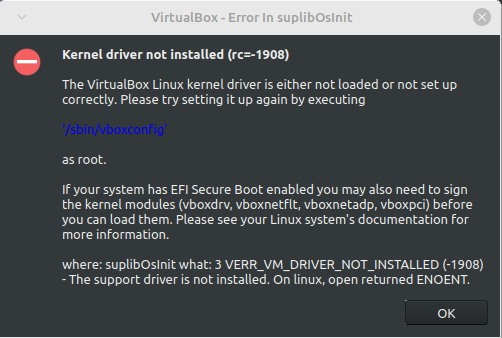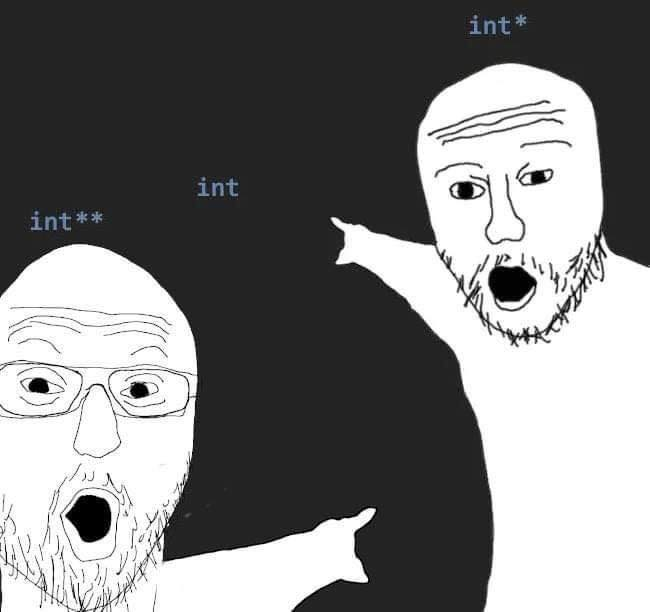
I tried looking into this myself but I couldn’t really find much about this error. The only solutions I could find didn’t work for me. The first one was to use mokutil but at the point where I was supposed to run sudo mokutil --import MOK.der it gives me the error message “Failed to get file status, MOK.der” even though I did everything it told me to do. The other one was to disable secure boot and then run sudo '/sbin/vboxconfig' but even though it looked like it worked, I’m still getting the error message. I have re-enabled secure boot, so you don’t have to worry about that.
Is there something else I can try or does VirtualBox not work in Linux Mint for some reason?
if you just need software to set up virtual machines you might look into Gnome Boxes or virt-manager which don’t require external kernel modules like Virtuap Box to work
anyway these issues typically happen on Ubuntu based distros (like Linux Mint) because your linux kernel is to new for the Virtual Box version (or the Virtual Box version is simply too old)
So I tried virt-manager but it’s giving me an error message about not being able to connect to “libvirt qemu:///system” and it wont let me install a virtual machine. I’m assuming that I’m supposed to download “libvirtd”, but I can’t figure out how to install it. I think it wants me to build it from the source but there doesn’t seem to be a guide on how to do that.
Yayy, I have the same problem.
Try a
sudo systemctl enable --now libvirtdI dont know how manual everything is in Mint
Also add your user to thr libvirt group
groupadd libvit sudo usermod -aG libvirt $USERJust FYI, if you want to enable and start, you can use
systemctl enable --now ....
deleted by creator
Are you using a package manager or downloading everything from virtualboxs website? When I installed virtual box earlier today it all worked fine so that’s why I ask.
I installed it through apt with just
sudo apt install virtualbox-7.0. I also downloaded the deb file from their website but, at least when installed through apt, it just ignores it and uses the version from Mint’s repository anyways.Edit: Because I just checked and you can’t install it directly like that anymore, I first tried installing VirtualBox a few months ago, with an older version of Linux Mint. When I tried installing it several hours ago, it was with the deb file but for some reason apt still selects a different version when it actually installs it.
OK, why are you installing it from a deb file and not just from your repo?
Try that first.How much of my comment did you read before replying?
I read that you installed a specific version months ago, but now installed it from a .deb file recently.
I’m asking why you don’t justsudo apt install virtualboxnow?I literally stated in my comment that you can’t install it like that anymore. The reason why is because you get an error saying “E: Package ‘virtualbox-7.0’ has no installation candidate”. This means that in Linux Mint, you have to install it via the deb file.
Ok thanks, I might try those later if I can’t get VirtualBox working.
virt-manager
I’ve used VirtualBox for years and only just tried virt-manager. I wish I had tried years ago, so much simpler and it is in my distro’s default repository.
I tried virt-manager but it’s giving me an error message about not being able to connect to “libvirt qemu:///system” and it wont let me install a virtual machine. I’m assuming that I’m supposed to download “libvirtd”, but I can’t figure out how to install it. I think it wants me to build it from the source but there doesn’t seem to be a guide on how to do that.
I’m assuming that I’m supposed to download “libvirtd”, but I can’t figure out how to install it.
Try
sudo apt install libvirt-daemon-system libvirt-clientsin the terminal and rebooting the system.It stated that they were already installed so I went through the process of re-installing them and rebooting the computer, which seems to have fixed the problem. I wont really be able to test it much right now because of how late it is for me but I was able to at least start the installation for Windows XP.
On fedora its
sudo dnf install qemu qemu-kvm virt-managerVirt-manager alone is just the viewer, its also intended to be used for things like remote viewing. This would be an easy solution
I’m currently installing virt-manager but I ran into a problem with Gnome Boxes where I’m trying to run a Windows XP virtual machine but I can’t figure out how to get files from my host to the guest. Apparently, I need some software to be running on the guest but the website that I need to download the software from doesn’t work in internet explorer and I obviously can’t just download it on the host and transfer it to the guest.
Yes this seems to be a Gnome Boxes Flatpak problem. I like that it works as a flatpak, but unsure if this can be fixed, I think its a known limitation.
Oh yes, the spice guest addition. This will be needed on every Spice VM
First of all, check that hardware virtualization is enabled in your UEFI setup.
You need to have packages virtualbox-dkms and linux-headers installed (together with all their dependencies, but you don’t have to check them manually). linux-headers must be of the same version as linux-image. That’s all that you need to get driver properly built. Don’t listen those users who recommend you to remove and reinstall these packages or install additional packages manually, this kind of magic doesn’t work.
Also note that you cannot use kvm and virtualbox simultaneously. If you are using some kvm-based virtualization system, it causes a conflict.
Really try virt-manager with qemu and kvm. It doesnt need any kernel mods.
🏆
virt-manager and libvirt. That works quite well and is easy to use. Virtualbox not so much.
Is there something else I can try
I use virt-manager, since it uses KVM which should already be present in the kernel.
How similar to VirtualBox is virt-manager? I’ve only ever used VirtualBox but if virt-manager is easy to use, I have no problem trying it out.
Gnome’s Boxes is pretty easy to use and of course uses qemu + KVM. This would be a type 1 hypervisor vs. Virtualbox’s type 2. It is point and click like Virtualbox. You don’t need to use Gnome’s DE to use Boxes.
I have seen people post about your specific error for years when using the virtualbox website’s repository instead of their own distro’s repository (if it exists).
I just tried Gnome Boxes and it seems to work mostly fine but the only problem I’m having is that I’m trying to run a Windows XP virtual machine but I can’t figure out how to get files from my host to the guest. Apparently, I need some software to be running on the guest but the website that I need to download the software from doesn’t work in internet explorer and I obviously can’t just download it on the host and transfer it to the guest.
In Boxes, power down your XP VM, click Settings -> Sharing Panel -> Enable Sharing toggle. Click File Sharing and enable File Sharing. Power on the VM.
At that point you should be able to drag and drop from your host direct into your VM for a file transfer.
You can also click the vertical dots menu in the Guest’s console “screen” and click Send File… menu option.
In the same menu you can click Devices & Shares -> Realtek USB or whatever -> Local Folder -> Select from the dropdown for the Host’s folder that you’d like to share -> Save -> Make sure Toggle on the right is on.
Then your folder, I believe in XP, will show up as a removable drive like a USB drive would.
Ok so I’ve already determined a solution for Boxes but I should mention that none what you said works for me. I’m not sure if I have a different version of Boxes than you (even though the only version that seems to exist is the one on flathub) but there is no sharing panel in settings. The only three options in settings is keyboard shortcuts, help and about boxes. When I’m running a VM, the option for “send file” is grayed out and can’t be selected.
For “devices & shares” that is, at least for me, located in the preferences for each VM. I can’t use USB devices because it’s not supported in the flatpak version and if I try to use the shared folders option, the folder I specified doesn’t show up in the VM. From what I can tell this might be an issue specific to some guests, like Windows XP, because Boxes links to a specific program that the guest needs to be running but when I try to run it in Windows XP, I get an error message stating that Windows XP isn’t a supported guest.
The only solution that seems to work for me, is taking the files I want to use in the VM and compress them into an iso file (if they’re not already) and mount it to the VM. It might be tedious but it’s the only thing that seems to be working for me.
I probably wouldn’t describe it as similar, but virt-manager is fairly simple but powerful at the same time (like it will let you expose more advanced KVM/QEMU features like PCIe passthrough and similar).
But like the other guy said, gnome boxes is very straight forward and probably more similar in it’s simplicity.
They both use QEMU + KVM, so you can have both virt-manager and boxes installed at once, and I believe virt-manager (probably boxes too) easily let you use existing VirtualBox .vdi files, if you’ve got an existing VM you want to run. Also like I said before, KVM is already mainlined into the Linux kernel, so you don’t have to install sketchy kernel modules and stuff.
I’ve only used VirtualBox once though, so I can’t really compare them.
I tried both virt-manager and Gnome Boxes but I’m having issues with both of them.
Gnome Boxes works mostly fine but I can’t seem to get files from the host to the guest. It says that the guest is supposed to have some special software but I’m trying to use Windows XP and I can’t seem to figure out how to get the required software because the website doesn’t work in internet explorer and I obviously can’t just download it from the host and transfer it over.
For virt-manager, it’s giving me an error message about not being able to connect to “libvirt qemu:///system” and it wont let me install a virtual machine. I’m assuming that I’m supposed to download “libvirtd”, but I can’t figure out how to install it. I think it wants me to build it from the source but there doesn’t seem to be a guide on how to do that.
It says that the guest is supposed to have some special software
That sounds like virtio-win. I usually use the iso and mount it from virt-manager, but if the internet is working then I guess you can download the exe.
I’m assuming that I’m supposed to download “libvirtd”
Just searched it up, something like this should work:
sudo apt install qemu-kvm libvirt-clients libvirt-daemon-system bridge-utils virtinst libvirt-daemonSorry I don’t have too much experience with gnome boxes either, I mostly use virt-manager.
Afaik Boxes it not developed anymore? May be wrong
So I tried virt-manager but it’s giving me an error message about not being able to connect to “libvirt qemu:///system” and it wont let me install a virtual machine. I’m assuming that I’m supposed to download “libvirtd”, but I can’t figure out how to install it. I think it wants me to build it from the source but there doesn’t seem to be a guide on how to do that.
As others have said, there’s no reason not to be using virt manager with qemu/KVM at this point
This should get you started: https://hrishikeshpathak.com/blog/install-and-configure-linux-virtual-machine-using-virt-manager/
Try
sudo apt-get install linux-headers-$(uname -r)
Then reboot your machine. Virtualbox needs the kernel headers to work.
I tried that but It’s giving me the error message
E: Unable to locate package kernel-headers.My bad, I haven’t run Debian based distros for a while. Run this instead
sudo apt-get install linux-headers-$(uname -r)
I’ve edited my comment
It’s telling me that they are already installed:
j@j-HP-Notebook:~$ sudo apt-get install linux-headers-$(uname -r) [sudo] password for j: Reading package lists... Done Building dependency tree... Done Reading state information... Done linux-headers-5.15.0-88-generic is already the newest version (5.15.0-88.98). linux-headers-5.15.0-88-generic set to manually installed. The following packages were automatically installed and are no longer required: brave-keyring libu2f-udev linux-headers-5.15.0-76 linux-headers-5.15.0-76-generic linux-headers-5.15.0-78 linux-headers-5.15.0-78-generic linux-headers-5.15.0-79 linux-headers-5.15.0-79-generic linux-headers-5.15.0-82 linux-headers-5.15.0-82-generic linux-headers-5.15.0-83 linux-headers-5.15.0-83-generic linux-headers-5.15.0-84 linux-headers-5.15.0-84-generic linux-headers-5.15.0-86 linux-headers-5.15.0-86-generic linux-image-5.15.0-76-generic linux-image-5.15.0-78-generic linux-image-5.15.0-79-generic linux-image-5.15.0-82-generic linux-image-5.15.0-83-generic linux-image-5.15.0-84-generic linux-image-5.15.0-86-generic linux-modules-5.15.0-76-generic linux-modules-5.15.0-78-generic linux-modules-5.15.0-79-generic linux-modules-5.15.0-82-generic linux-modules-5.15.0-83-generic linux-modules-5.15.0-84-generic linux-modules-5.15.0-86-generic linux-modules-extra-5.15.0-76-generic linux-modules-extra-5.15.0-78-generic linux-modules-extra-5.15.0-79-generic linux-modules-extra-5.15.0-82-generic linux-modules-extra-5.15.0-83-generic linux-modules-extra-5.15.0-84-generic linux-modules-extra-5.15.0-86-generic Use 'sudo apt autoremove' to remove them. 0 upgraded, 0 newly installed, 0 to remove and 0 not upgraded.Tangentially related, you can clean out those old kernels if you install byobu and run purge-old-kernels, in case you don’t want to apt autoremove
Then restart you machine. That normally needs to be done after installing virtualbox. See if it works.
I already restarted my computer twice after installing it, is there any reason I would have restart my computer a third time?
Ok then, it’s probably the dkms shitting the bed. Follow this
Is there something specific from that link that I’m supposed to use because I tired the top solution and it just gave me a bunch of error messages:
j@j-HP-Notebook:~$ sudo apt-get install build-essential linux-headers-`uname -r` dkms virtualbox-dkms [sudo] password for j: Reading package lists... Done Building dependency tree... Done Reading state information... Done dkms is already the newest version (2.8.7-2ubuntu2.1mint1). build-essential is already the newest version (12.9ubuntu3). linux-headers-5.15.0-88-generic is already the newest version (5.15.0-88.98). The following packages were automatically installed and are no longer required: libqt5help5 libqt5sql5 libqt5sql5-sqlite libqt5xml5 libsdl-ttf2.0-0 Use 'sudo apt autoremove' to remove them. The following additional packages will be installed: libgsoap-2.8.117 liblzf1 libvncserver1 virtualbox virtualbox-qt Suggested packages: vde2 virtualbox-guest-additions-iso The following packages will be REMOVED: virtualbox-7.0 The following NEW packages will be installed: libgsoap-2.8.117 liblzf1 libvncserver1 virtualbox virtualbox-dkms virtualbox-qt 0 upgraded, 6 newly installed, 1 to remove and 0 not upgraded. Need to get 0 B/46.5 MB of archives. After this operation, 43.0 MB disk space will be freed. Do you want to continue? [Y/n] y debconf: DbDriver "config": /var/cache/debconf/config.dat is locked by another process: Resource temporarily unavailable (Reading database ... 642834 files and directories currently installed.) Removing virtualbox-7.0 (7.0.12-159484~Ubuntu~jammy) ... debconf: DbDriver "config": /var/cache/debconf/config.dat is locked by another process: Resource temporarily unavailable dpkg: error processing package virtualbox-7.0 (--remove): installed virtualbox-7.0 package pre-removal script subprocess returned error exit status 1 dpkg: too many errors, stopping vboxdrv.sh: failed: modprobe vboxdrv failed. Please use 'dmesg' to find out why. There were problems setting up VirtualBox. To re-start the set-up process, run /sbin/vboxconfig as root. If your system is using EFI Secure Boot you may need to sign the kernel modules (vboxdrv, vboxnetflt, vboxnetadp, vboxpci) before you can load them. Please see your Linux system's documentation for more information. Errors were encountered while processing: virtualbox-7.0 Processing was halted because there were too many errors. E: Sub-process /usr/bin/dpkg returned an error code (1) j@j-HP-Notebook:~$ sudo modprobe vboxdrv modprobe: ERROR: could not insert 'vboxdrv': Operation not permitted
deleted by creator
That doesn’t work for me as they give me error messages:
j@j-HP-Notebook:~$ sudo apt remove virtualbox-dkms [sudo] password for j: Reading package lists... Done Building dependency tree... Done Reading state information... Done Package 'virtualbox-dkms' is not installed, so not removed 0 upgraded, 0 newly installed, 0 to remove and 0 not upgraded. j@j-HP-Notebook:~$ sudo apt-get install make gcc build-essential linux-headers-'uname -r' dkms Reading package lists... Done Building dependency tree... Done Reading state information... Done E: Unable to locate package linux-headers-uname -r j@j-HP-Notebook:~$ sudo apt install virtualbox-dkms Reading package lists... Done Building dependency tree... Done Reading state information... Done The following packages were automatically installed and are no longer required: libqt5help5 libqt5sql5 libqt5sql5-sqlite libqt5xml5 libsdl-ttf2.0-0 Use 'sudo apt autoremove' to remove them. The following additional packages will be installed: libgsoap-2.8.117 liblzf1 libvncserver1 virtualbox virtualbox-qt Suggested packages: vde2 virtualbox-guest-additions-iso The following packages will be REMOVED: virtualbox-7.0 The following NEW packages will be installed: libgsoap-2.8.117 liblzf1 libvncserver1 virtualbox virtualbox-dkms virtualbox-qt 0 upgraded, 6 newly installed, 1 to remove and 0 not upgraded. Need to get 0 B/46.5 MB of archives. After this operation, 43.0 MB disk space will be freed. Do you want to continue? [Y/n] y debconf: DbDriver "config": /var/cache/debconf/config.dat is locked by another process: Resource temporarily unavailable (Reading database ... 642834 files and directories currently installed.) Removing virtualbox-7.0 (7.0.12-159484~Ubuntu~jammy) ... debconf: DbDriver "config": /var/cache/debconf/config.dat is locked by another process: Resource temporarily unavailable dpkg: error processing package virtualbox-7.0 (--remove): installed virtualbox-7.0 package pre-removal script subprocess returned error exit status 1 dpkg: too many errors, stopping vboxdrv.sh: failed: modprobe vboxdrv failed. Please use 'dmesg' to find out why. There were problems setting up VirtualBox. To re-start the set-up process, run /sbin/vboxconfig as root. If your system is using EFI Secure Boot you may need to sign the kernel modules (vboxdrv, vboxnetflt, vboxnetadp, vboxpci) before you can load them. Please see your Linux system's documentation for more information. Errors were encountered while processing: virtualbox-7.0 Processing was halted because there were too many errors. E: Sub-process /usr/bin/dpkg returned an error code (1)I guess the “uname -r” part should be $(uname -r) but this isn’t the problem with vbox IMO
Then just do the last step, see what happens.
I’m not sure what you mean but it doesn’t matter because VirtualBox still isn’t working and I’ve decided to uninstall it and try some alternatives that people have mentioned.
Does loading the kernel module help, assuming it’s installed?
sudo modprobe vboxdrv
No, it’s giving me the following error message:
j@j-HP-Notebook:~$ sudo modprobe vboxdrv [sudo] password for j: modprobe: ERROR: could not insert 'vboxdrv': Operation not permitted
That’s really odd. I’m running Linux Mint Debian Edition 6 and I installed virtual box from the oracle website just fine.
As others have said, try Gnome Boxes and see if they works. If it also has issues then it’s something with your system.
I actually just tried Gnome Boxes and it seems to work mostly fine but the only problem I’m having is that I’m trying to run a Windows XP virtual machine but I can’t figure out how to get files from my host to the guest. Apparently, I need some software to be running on the guest but the website that I need to download the software from doesn’t work in internet explorer and I obviously can’t just download it on the host and transfer it to the guest.
Have you tried to download it on the host to a USB (formatted with fat32) and then in Boxes select that usb in Windows to copy and run the software?
While I have already found a solution (and with it found out that the software doesn’t even work in windows xp) the only way to download Boxes that I could find was through flathub, which doesn’t allow usb devices for some reason. What does work is that I can just put all of the files I want transferred into an iso file and mount it to the VM.
Also, if there is a way to install Boxes outside of flathub, I’ll have to check it out tomorrow because of late it is for me right now.
Yes there is such a way.
deleted by creator
Use virt-manager or gnome boxes, they are both better and tend to run faster in my experience
I had the same problem (running Fedora 38), and this post really helped me - it goes through the whole MOK generation/enrollment and then provides a script to automatically sign the modules. I had to make a couple of adjustments to make it work on my system and to automatically load the modules with
modprobe, but now I just run/sbin/vboxconfig; /root/bin/sign-vbox-moduleseach time my kernel gets updated and can use VBox fine again.(Here‘s my adjusted version too in case that helps :)
Does your Kernel have a license?
I don’t know what that means, is there a way I can find out?
It works fine. Install the kernel driver like it’s telling you to.
Ok but how do I do that?













